5.67 billion homes are sold in the United States every year.
And there’s a nice chunk of that you can take for yourself.
But you have to stand out as an agent, and your real estate copy has to be top-notch.
Copywriting for real estate takes time to execute, let alone learn.
Your competition, who already knows how to write copy, is lightyears ahead of you.
That’s why today I’m going to teach you how to write great real estate copy.
If you still need help, you can reach out to a real estate copywriter like myself, and I’ll take the weight off of your shoulders.
I’m talking headlines, property descriptions, ads, the whole shebang!
Knowing how to write real estate copy will help you sell more property, get clients, and speed ahead of the local competition.
Keep reading if you want that kind of result.
Alternatively, enroll in my courses to learn how to write extremely effective copy or scale a writing business.
What is real estate copywriting, first of all?
Copywriting is the art and science of writing advertisements and marketing material that drives business growth. Plain and simple.
Real estate copywriting? It’s storytelling. You’re not listing features like “4 bedrooms, 2 baths.” No. You’re inviting readers to imagine waking up to sunlit rooms, hosting dinners in that spacious dining room, or enjoying a quiet evening in the cozy backyard. It’s about creating an emotional connection, making that property irresistible.
But it’s not just ads and property descriptions. There’s more to it. You’re also talking blogs, articles, newsletters, and social media content that positions a brand as the go-to in the real estate world. Think market trends, home improvement tips, neighborhood guides—all the good stuff that draws readers in and keeps them engaged.
Why do realtors need copywriting?
Whether you realize it or not, you’re writing sales copy every single day. Emails, social media posts, and text messages to clients are all forms of real estate copywriting.
Why is it important to learn? Firstly, it helps you stand out in a sea of listings. You can make a property pop so much online that people can’t help but click to see more. Good copywriting does that. It grabs attention in a way that a simple list of features never could.
Then, there’s the emotional connection. Buying or renting a home is a big deal, folks. It’s not just about square footage or the number of bathrooms. It’s about imagining your life unfolding there. Copywriting creates that vision, weaving a narrative that speaks directly to the heart.
And let’s not forget clarity and persuasion. A skilled copywriter can take complex information (think legal stuff, financial details, technical features) and make it digestible. Plus, they know how to nudge readers in the right direction, gently guiding them towards taking action, be it scheduling a viewing or picking up the phone.
Writing real estate ads
If your ad is boring, no one is going to buy the property.
Why do you think that no one has been contacting you lately?
It’s probably because your copy sucks, so let’s fix that.
There are several components of great real estate ad copy, beginning with the headline.
Writing real estate headlines
The headline draws the audience to read the ad. It’s hand-down the most important element of writing real estate listings.
Look at the titles of these homes for sale. Do any of them sound appealing?
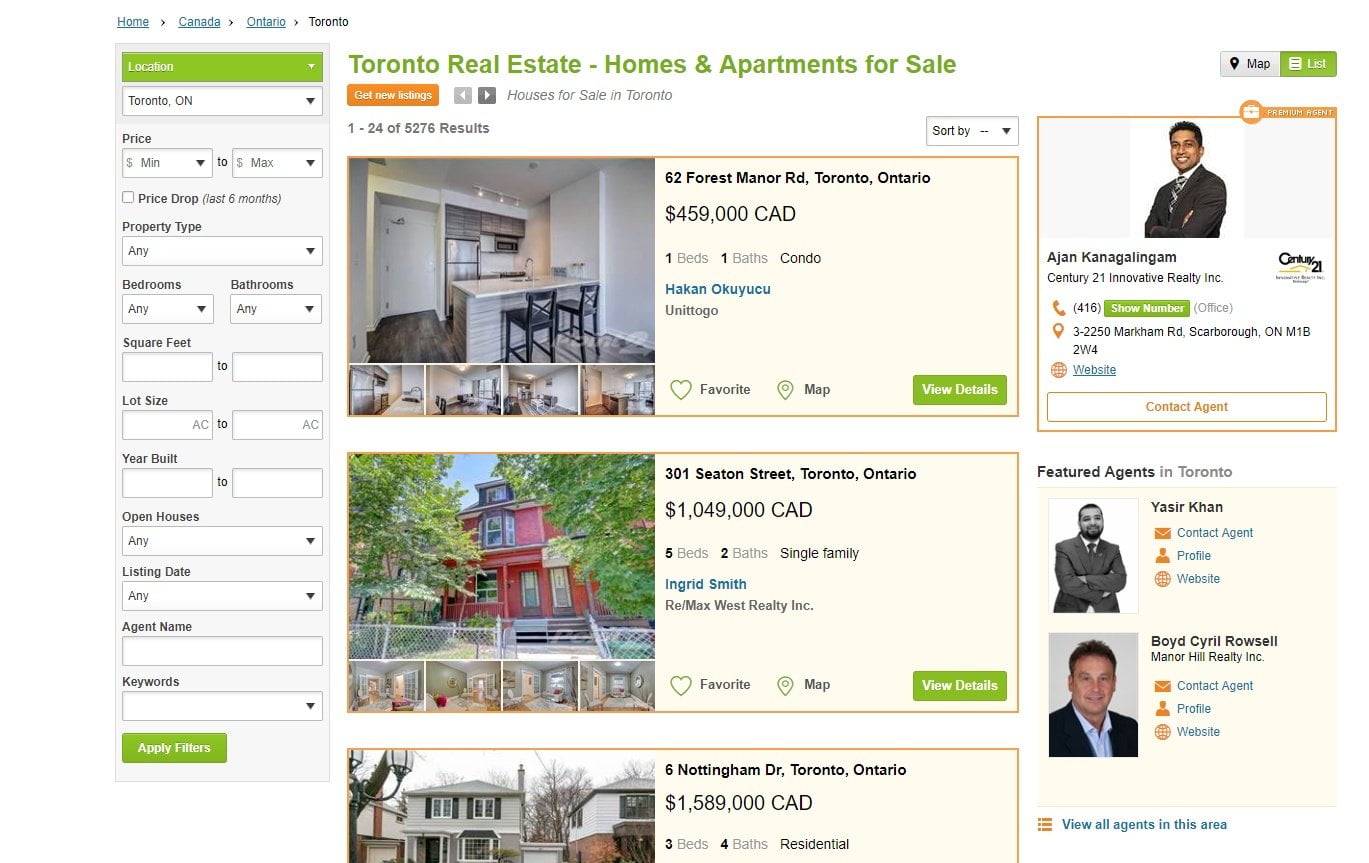
I’ll give you a hint — nope!
It’s literally just the address, followed by basic information. Imagine if your listing had an exciting headline and how much you’d stand out.
Whether you’re writing copy for a Facebook ad, Kijiji listing, or magazine, the following rules all apply.
You can also use a tool like Jasper to let artificial intelligence do all of the work for you.
Price based headlines
Let’s be real. The price of a house is a huge reason why it’s going to be sold or not.
That means it’s the perfect element to include in your headline to draw interested customers in.
However, you have to understand your target market a bit more deeply. Do you normally sell to people who buy homes to invest in? People, that are lower income? This will change how you write your headline. Here are some examples:
- “Priced to Sell Fast”: This is effective because it promotes urgency. It makes people feel that they are going to miss out on a great deal, and they will be more likely to click on your ad.
- “Make an Offer!”: One of the staple copywriting principles is calls to action — telling the reader to take some form of action, or in this case, make an offer. When they check out your ad, it will be on their mind.
- “Incredible Investment Opportunity”: Obviously, you have to be telling the truth. Don’t use this headline on the house you know is going to tank faster than your high school grades. Investors are looking to, of course, invest in a property. If you’re confident that it will have a good ROI, mentioning it in the headline will attract the right buyers. Many times they have to browse through listings and find these types of properties themselves. A.K.A, you’re also saving them time.
- “Priced Below the Appraisal Amount“: This screams a great deal and saving money. Who doesn’t want that? Most people are going to be very budget-sensitive when purchasing property, so you’re speaking to their emotions and needs.
Location-based headlines
The price isn’t everything. Location and setting, as you already know, is a very important factor in selling homes. Here are some ways you can integrate that into your real estate headlines:
- “Breathtaking View”: Are you selling a property that overlooks the city? A beautiful lake or something similar? Then you need to add this to your headline. This needs to be accompanied by high-quality photos of the “breathtaking view,” of course.
- “Heart of the Metropolis”: Some people love living in the heart of the big city. Think New York City, Toronto, Los Angeles, or Chicago. The hustle and bustle get them excited. They love the noise and stimulation. If you’re selling property in a metropolitan area, like condos or apartments, I’d suggest giving this a shot.
- “Tucked Away in Private”: Not everyone wants a property that screams attention. Some prefer a relaxed and private environment. Are you selling a property that’s tucked away and hidden? Odds are you will get people who value their privacy, and this headline will resonate with them.
Curb appeal headlines

Looks matter. You know that, and your customers know that. Are you selling a property that has a unique appearance or looks like a miniature version of Buckingham Palace? Let it be known in your headline.
- “Should be on The Cover of a Magazine”: You wouldn’t even need to see a picture of the house to know that it’s probably going to have a perfect lawn, big pillars, a fountain, and a few garages. Okay, maybe not that exactly, but you get the point. For very aesthetic and beautiful properties, try this headline out.
- “Looks Like It’s Worth a Million, But It’s Not Even Half That”: This headline works well because it implies that the house looks incredible, but it’s also a steal at the same time. You’ll definitely get more people viewing your ads with this title.
- “Your Friends Will Be Envious”: Who doesn’t like to be looked up to? And let’s be real, plenty of people buy homes to impress others.
Amenities headlines
The house, location, and price aren’t everything. What’s included in the property or located nearby is a huge selling point that you can integrate into property copywriting. Here are a few ideas to try out:
- “Live on The Golf Course”: This would apply to both properties that are located on a golf course or close to one. It doesn’t have to be applied to only golf, though. Consider what similar athletic amenities are related to the property and tie that into your headline. If there are tennis courts, I bet “Like Tennis? Take a Swing at This Sports Condo” would work pretty damn well.
- “Say Goodbye to Your Lawnmower”: You could use this headline in a couple of different instances. Apartments and condos would be the first way, of course. Secondly, you can implement this for properties where lawn maintenance is included.
- “Close to Everything”: Straight to the point. If there are grocery stores, shops, restaurants, and basic amenities nearby, it can be a great selling point.
Writing real estate property descriptions
What do you think of this property description? And be honest.
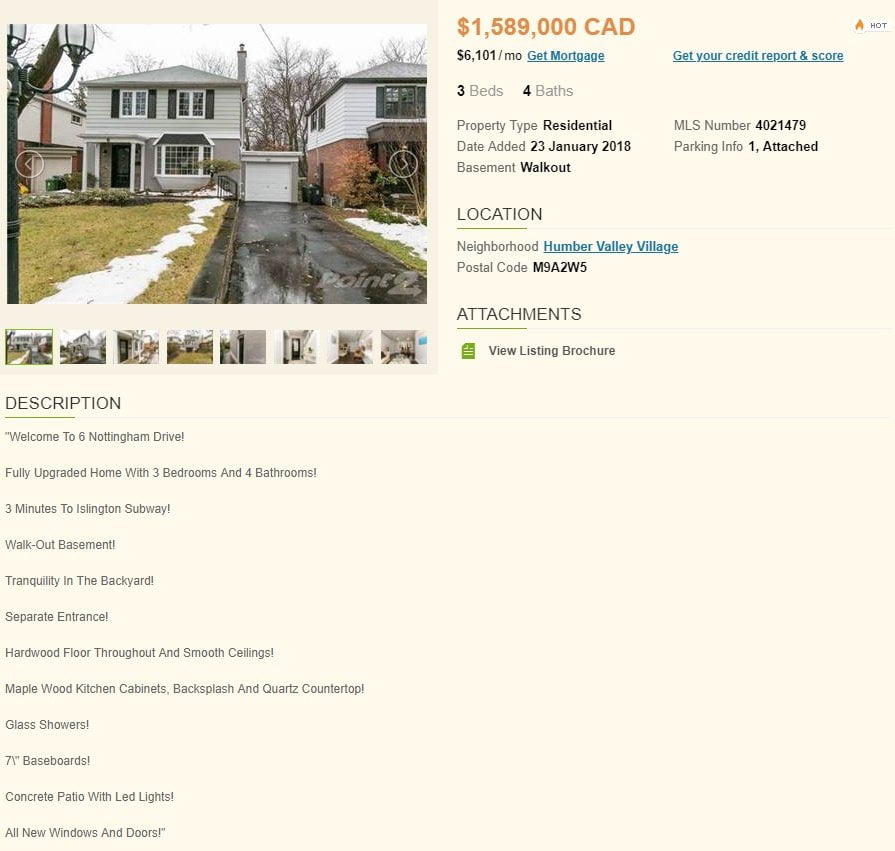
If you said it looks good, I have some bad news.
You really need to tune up your copywriting skills because this listing is pretty bad, actually.
This is what it does wrong:
- Mostly just state the features of the house.
- Boring text and vague.
- Doesn’t paint a picture in your mind.
- No unique selling point.
- No story or history.
- Lack of words that sell.
With that in mind, these are tips for writing exciting real estate property descriptions that sell.
State the benefits, not just the features
The features of the house are factors like age, bedrooms, bathrooms, and similar information. Think factual.
Benefits are what the customer is really going to get out of the property and usually, but not always, include emotionally charged words.
I wrote an entire guide to features versus benefits that you should read to understand this strategy in-depth.
For example, instead of the above ad stating, “Tranquility in the backyard,” it should say, “A tranquil backyard that you can escape to after work, with enough space for barbecues and great privacy.” I just thought of that off the top of my head, and it’s 100 times better than what they have!
While you’re writing your property description, ask yourself what the benefit is of every feature you state. Check out this listing — they did a fairly good job.
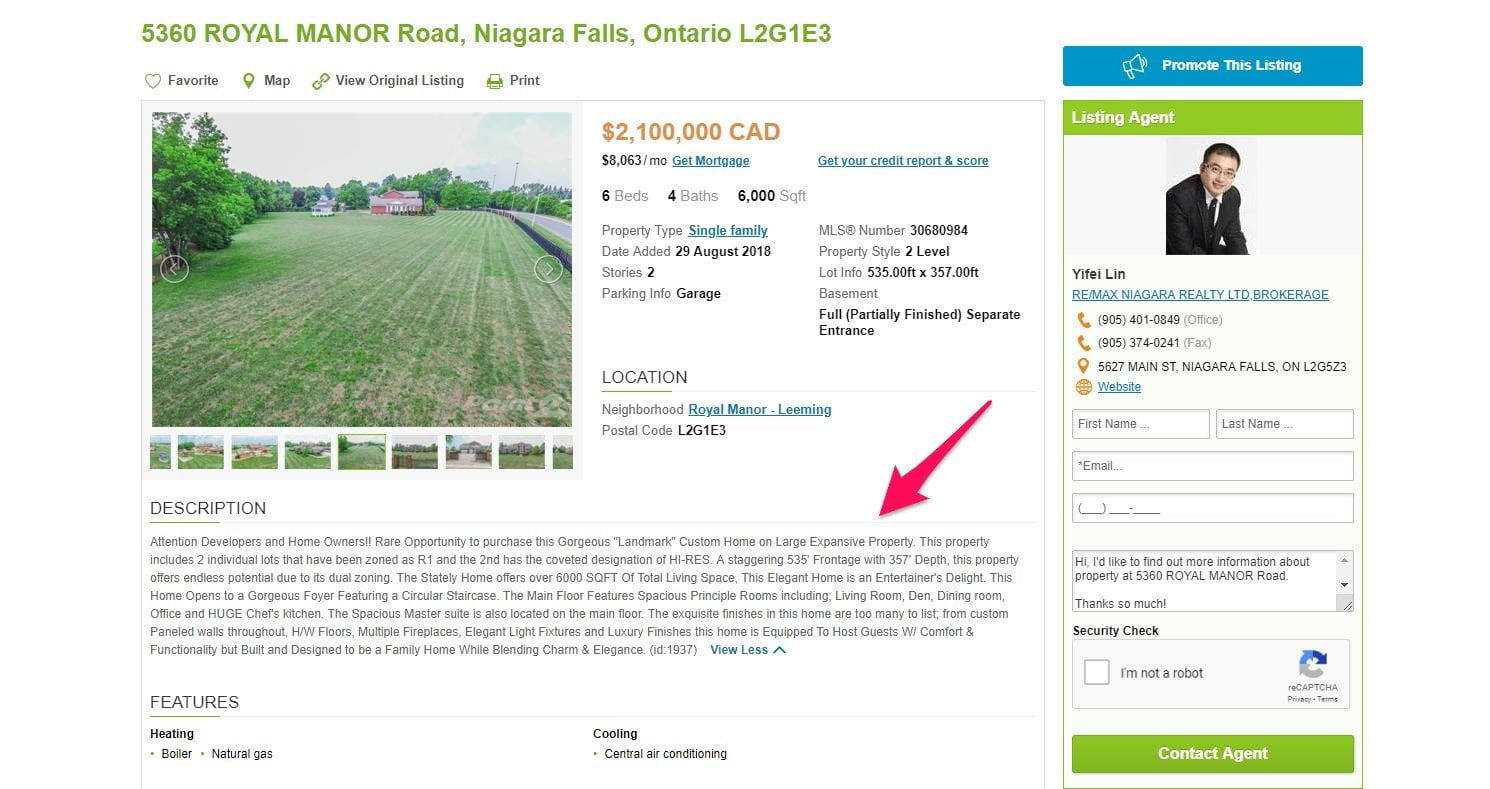
The first words are “Attention Developers and Home Owners,” instantly grabbing the awareness of these two audiences. It goes on to state that it includes two lots, which have already been zoned, and has “endless potential” because of it.
It features 6,000 square feet, which makes it an “Entertainer’s Delight.” Once again, they know who they are targeting. The listing then says that there are too many exquisite finishes to list and that it’s a family home mixed with luxury.
Not the absolute best real estate description I’ve seen, but it’s way better than most. Take notes.
Paint a picture in the mind of the customer
When someone reads your listing, they need to feel excitement and curiosity. They should be oozing to give you a phone call to come to view the property. Learn from this listing. I didn’t crop out the real estate agent, so if you buy it, you better give me a commission 😉
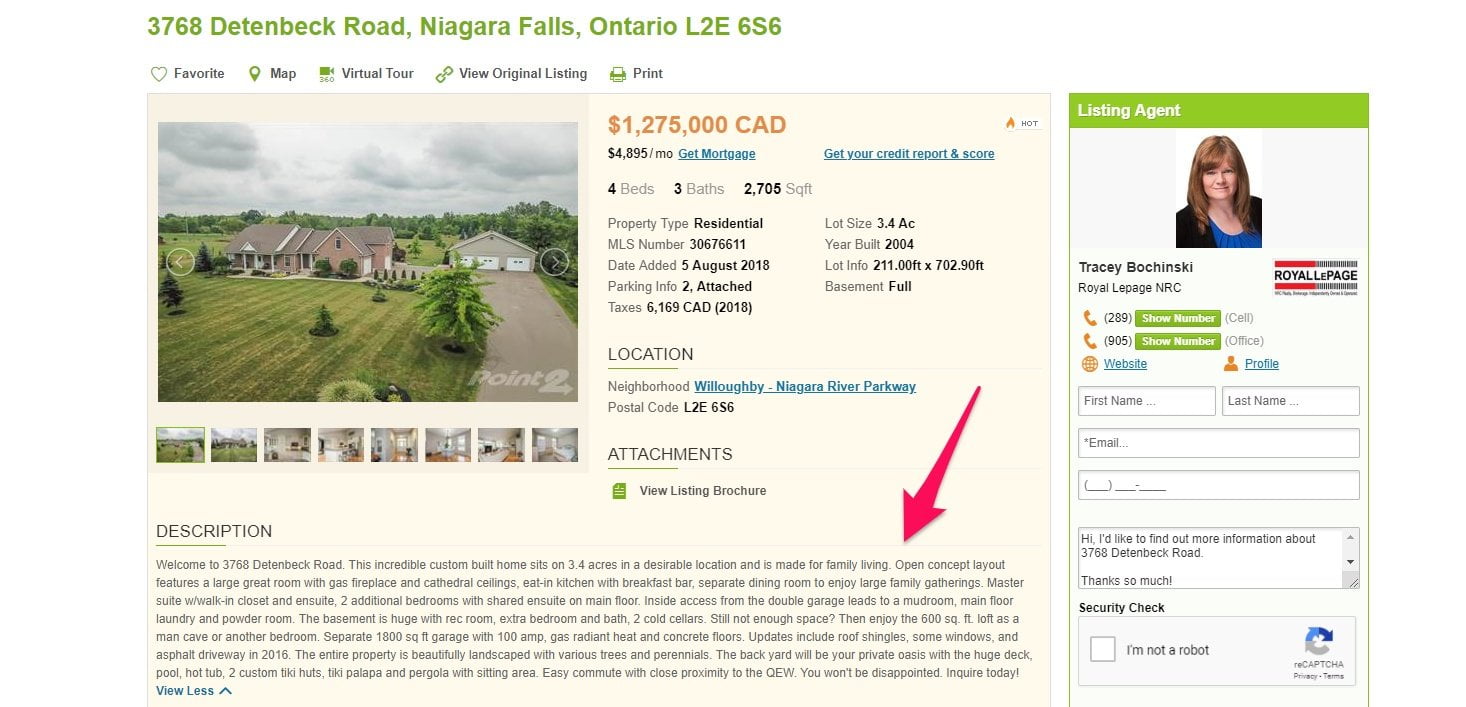
Note how the description details this home has an open concept layout, cathedral ceilings, breakfast bar, and eat-in kitchen. The copy “enjoy large family gatherings” further helps us imagine what living in this house would be like.
Heck, there’s even a mudroom and powder room! Whatever that is.
This property also includes a loft “as a man cave or another bedroom,” and “the entire property is beautifully landscaped with various trees and perennials. The back yard will be your private oasis with the huge deck, pool, and hot tub”.
See how they describe it so well that it paints a picture in your mind? Do that for your descriptions, too.
Tell a story
This won’t work for every property, but it can be a massive selling point if there are real history and heritage behind it. For example, I took a browse through the Circa house listings that focus on old homes. Look at this real estate copywriting sample description.

First of all, the intro with “once in a lifetime opportunity” is an awesome copywriting strategy. It makes you feel like you could buy a very rare property that you’d kick yourself over if you didn’t.
And geez, just read this: “If these walls could talk, they would tell you of the famous morning of April 19, 1775, when the Minuteman gathered here to muster before their history-making march to the Concord.” That’s just a beautiful copy right there. I’m not a history geek, so I have no clue what they’re talking about, but even I’m interested!
Storytelling gets readers emotionally involved with the writing and makes the property stand out among the competition. Are you selling any property that has an interesting history or story? Don’t let it slip by. It could be what helps you land the sale.
Use words that sell
Every word has an emotion or idea attached to it when it’s read. That’s why when you write real estate copy, be mindful of every word you choose. Try using some of these proven power words.
“Free”
Dan Ariely, a professor at Duke University, performed a study to discover how people reacted to free items. 398 MIT students partook in the experiment.
He recorded the reaction between students taking a Hershey’s candy versus a Lindt truffle. Both of them are delicious, by the way.
But the Lindt truffle is much more expensive and of higher quality. When Dan offered students a free Hershey’s and a heavily discounted Lindt, a large majority opted for the free candy.
Why is this? Because people love free stuff.
When you’re writing your property description, try to tie in some kind of free element. This could be a free viewing, a free brochure — anything free.
This is what we call a lead magnet.
“Special”
While many individuals want to blend in with the crowd, some want to stand out. With that in mind, is there anything “special” about the property you’re selling?
Perhaps it uses rare materials, has cool built-in amenities, or is located near a popular monument. Find a way to make the property that you’re listing sound special.
“New”
New means fresh, and modern, and is associated with quality. Maybe you can’t claim that you’re selling a new property in terms of its age, but it may be “new” to being sold 😉
You can also implement this power word by stating new fixtures or renovations that were added recently.
“Safe”
Every homeowner wants them and their family to be safe. Mention that the property you’re selling is located in a safe neighbourhood or area of the city — if it is, of course. Bonus points if you can cite actual data on how low crime is compared to other nearby locations.
Safety isn’t just measured in terms of the area but also security systems. Does the property have cameras, good alarms, or other ways to keep it secure? Ensure that you mention this.
Writing a real estate agent bio
The property might be perfect, and the description can be crisp, but you also need to write copy about yourself.
You need to cut through the static that is the real estate industry as a whole. New agents are popping up daily, but that doesn’t mean you can’t beat them.
Learning how to write a great real estate profile will get you more clients and commissions while also sharpening your brand image.
Let’s look at some ways you can do so with real-world examples, too.
Don’t be afraid to brag
Bragging works. If you have credentials to show off, then show them off you should. Look at this father and son profile.

They were the #1 top-producing realtors for re-sale homes in their region for three years. Not only that, but they were the #1 producing realtors in successful transactions for buyers.
As a matter of fact, bragging helps when you really know your stuff. It works as social proof and makes potential customers trust you more. They know they’re working with a pro, not an amateur.
What kind of awards of experience do you have that you could show off?
Tell a story about yourself, even if it’s brief
People want to work with people.
If you’re vague about who you are and how you got to where you are, it’s going to leave a lot of questions in the minds of the audience.
To avoid that, I recommend telling a story in your real estate profile, just like the father and son did above. They mentioned that they are the 4th and 5th generation of their family and how their ancestors immigrated in 1875.
This allows people to relate to you, connect emotionally, and have a better understanding of who you are before a consultation. Don’t be afraid to throw in some personality and let your true character shine through.
Consider this: would you rather work with a boring and negative real estate agent or one that’s fun and vibrant?
What’s in it for them?
Remember what you learned about features versus benefits earlier? You need to apply that to your real estate agent biography, as well.
Check out Matt Guthrie’s profile.

The last paragraph nails this strategy. It states that Matt’s goal is to help his clients live better lives, create wealth through investing, and empower his team. It even finishes with a call to action to phone him. Great work!
Creating real estate blog content
Yes, real estate agents and companies need to be blogging, too.
Marketers like yourself generate up to 67% more leads by blogging on behalf of their business. Sure, you’re an agent or realtor, but when you advertise your business, you’re a marketer, as well.
Make sure you build a website with a custom domain and hosting by using a provider like Bluehost. It will make your brand stand out to potential clients.
Sharpening these skills will make you a full-stack entrepreneur, putting you way ahead of other local agents. Here’s how to write blog posts that generate traffic and real estate leads.
Step 1: Decide on a topic
The worst feeling is when you’re staring at the blank screen, trying to find an idea to write about.
Let’s skip that and jump straight to writing awesome content by using a free tool like Portent’s content idea generator.
Type in a keyword, hit the search button, and you’ll be given tons of inspiration.

You want to obviously attract relevant users, so you should be writing content about real estate.
Brainstorm what your customers would be asking about things such as:
- Buying their first home
- Mortgages
- Credit and debt
- Income and finances
- What to look for in a house
This brings me to my next point.
Step 2: Plan out your blog post
You should never write an article off the top of your head. It will slow you down, confuse you at times, and you’ll get writer’s block eventually.
If you get stuck writing all of the time, read my blog post on overcoming writer’s block. It’s life-changing.
That’s why I recommend taking a few minutes and planning out your content beforehand.
Open up WordPress, Weebly, or whichever CMS you’re using to write.
Map out the main points and sub-points that you’d like to talk about in your article. Take the time to research these to ensure they’re useful, and gather some references to help you write.
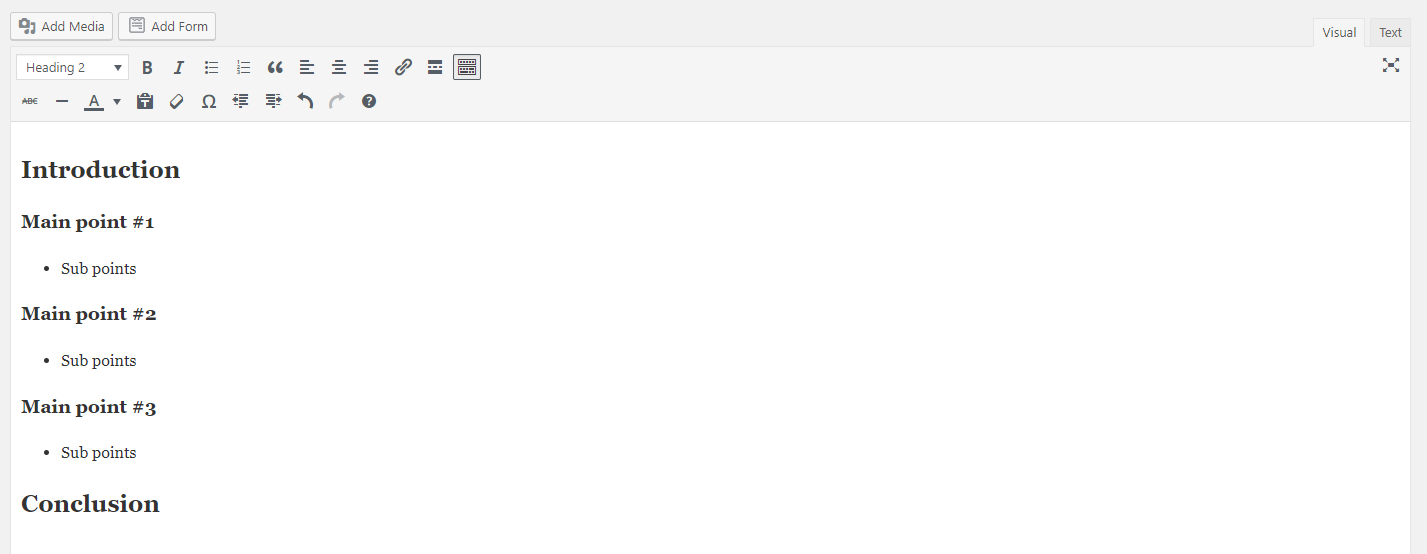
Step 3: Write that sucker!
Writing real estate blog content doesn’t have to be tough. There are some main focuses you should have every time you piece together content, including the following:
- Word count: The amount of words needed to rank on the first page of Google is going up and up. Backlinko and SerpIQ found the average first result to be 1,890 words and 2,450 words, respectively. It makes sense. People want longer content because it teaches them more things, and Google wants to only display the most useful listings.
- Visuals: This isn’t a newspaper. You need to include images to make blog posts more interesting and entertaining. Not only that, but infographics, charts, and graphs allow you to back up points and pack more value.
- Make it practical: Readers shouldn’t finish your blog post and think, “Okay, now what do I do?” They should know exactly what steps to take because you laid them out in an easily digestible format.
- Add in SEO keywords: Use Google’s keyword planner or another free tool to research keyword phrases. Include these in the title, URL, body, and header tags so you can rank for them and drive your organic traffic through the roof!
More real estate copywriting best practices
I wanted to summarize some of the key copywriting strategies realtors can use to generate more leads and commissions.
- Know Your Audience: Are you talking to first-time homebuyers, luxury estate seekers, or small business owners looking for commercial space? Tailor your message to speak their language.
- Highlight the Lifestyle: It’s not just a house; it’s a future home. Talk about Sunday brunches in the sunny kitchen or cozy movie nights in the living room. Make them dream.
- Use Vivid Descriptions: But keep it real. “Sun-drenched rooms” sound way better than “well-lit.” Just don’t overdo it. Nobody’s buying the “enchanted castle” vibe for a suburban three-bed.
- Focus on Benefits, Not Features: Sure, a “two-car garage” is great, but why? Is it because of the ample storage, or because it means not having to scrape ice off the windshield in winter?
- Be Concise: Get to the point. Space is a premium, both in terms of property and people’s attention spans.
- Use Strong Headlines: Grab their attention from the get-go. “Why This Could Be Your Dream Home” sounds more inviting than “House for Sale.”
- Include a Call to Action: Guide them on what to do next. “Schedule a Viewing Today” or “Imagine Coming Home to This – Let’s Make It Happen” can be powerful.
- Proofread: Spelling or grammar mistakes can hurt credibility. Double-check your work.
- SEO Matters: Use keywords naturally. If you’re targeting “family homes in Austin,” work that into your copy without forcing it.
- Tell a Story: If the property has history or a unique feature, share it. Stories sell.
Summing up real estate copywriting
Real estate is cutthroat.
Many aspire to be agents and to make millions, but so few make it.
Always remember this one thing in business: you can either beat the competition by delivering a better product or delivering better marketing.
In your case, it’s all about spicing up your copy to the point it makes you stand out as the best and gets you more clients.
This all begins with writing real estate ads and more specifically, the headline.
Headlines should instantly mention the selling point of the property, whether that relates to the price point, location, or amenities. Just taking the time to do this will put you ahead of so many agents.
Next up, is the description. Make it exciting. Make it fun. Write it so that the customer feels like they are living in the home already.
You can achieve this by painting a picture with words, like “A large patio in the backyard that’s great for spending time with the family and hosting barbecues.” It’s simple, and much more effective than just stating it has a big patio.
Secondly, add in storytelling. It isn’t always possible, but always take the opportunity if you can. Things to mention would include heritage, famous people that lived there, or if something historical occurred nearby.
Include high-resolution photos and your property listing will get more traffic than rush hour in Los Angeles.
Then it’s time to clean up your biography. Just like with listings, the same rules apply.
Use storytelling to explain your experience and expertise as an agent. Cite any awards or special certifications.
Include how customers will benefit from working with you; smooth transactions, quick sales, and little paperwork are a few ideas.
What are you waiting for? Go fix up your copy and get more real estate customers already!
Take your real estate copywriting skills to the next level with my online training.














